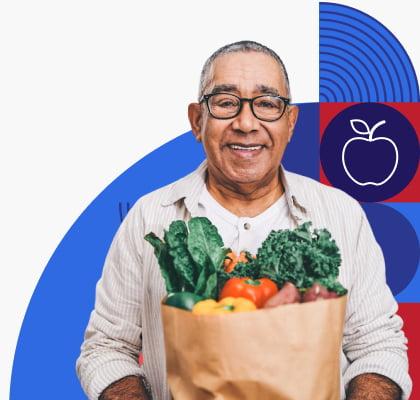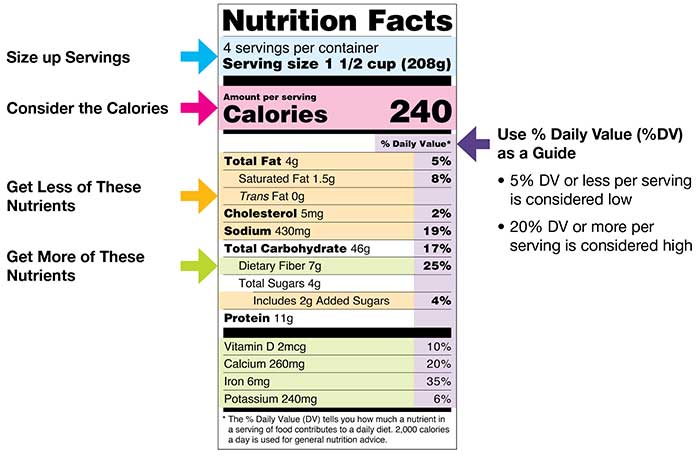Health Conditions
Eat Healthy

The Basics
Overview
Eating healthy means following a healthy eating pattern that includes a variety of nutritious foods and drinks. It also means getting the number of calories that’s right for you (not eating too much or too little).
Choose a mix of healthy foods.
There are lots of healthy choices in each food group! Choose a variety of foods you enjoy, including:
- Whole fruits — like apples, berries, oranges, mango, and bananas
- Veggies — like broccoli, sweet potatoes, beets, okra, spinach, peppers, and jicama
- Whole grains — like brown rice, millet, oatmeal, bulgur, and whole-wheat bread
- Proteins — like lean meats and chicken, eggs, seafood, beans and lentils, nuts and seeds, and tofu
- Low-fat or fat-free dairy — like milk, yogurt, cheese, lactose-free dairy, and fortified soy beverages (soy milk) or soy yogurt
- Oils — like vegetable oil, olive oil, and oils in foods like seafood, avocado, and nuts
Limit certain nutrients and ingredients.
Sodium (salt)
Sodium is found in table salt — but most of the sodium we eat comes from packaged food or food that's prepared in restaurants. Learn how to cut down on sodium [PDF - 881 KB].
Added sugars
Added sugars include syrups and sweeteners that manufacturers add to products like sodas, yogurt, and cereals — as well as things you add, like sugar in your coffee. Learn how to cut down on added sugars [PDF - 898 KB].
Saturated fat
Saturated fat comes from animal products like cheese, fatty meats and poultry, whole milk, butter, and many sweets and snack foods. Some plant products like palm and coconut oils also have saturated fat. Learn how to cut down on saturated fat [PDF - 1.1 MB].
Get a personalized MyPlate Plan to help you choose healthy foods.
What about alcohol?
Alcohol includes beer, wine, and liquor. If you choose to drink, drink in moderation — 1 drink or less in a day for women and 2 drinks or less in a day for men. And remember that drinking less is always better for your health than drinking more.
Health Benefits
A healthy eating routine can help keep you healthy.
Eating healthy is good for your overall health — and there are many ways to do it. Learn how to build a healthy eating routine [PDF – 1.6 MB].
Making smart food choices can also help you manage your weight and lower your risk for certain chronic (long-term) diseases.
When you eat healthy, you can reduce your risk for:
- Overweight and obesity
- Heart disease
- Type 2 diabetes
- High blood pressure
- Some types of cancer
Take Action
Make Small Changes
Making small changes to your eating habits can make a big difference for your health over time.
Make healthy swaps.
Try making 1 or 2 small changes this week. For example:
- Drink sparkling water instead of regular soda
- Try plain, low-fat yogurt with fruit instead of full-fat yogurt with added sugars
- Choose low-sodium black beans instead of regular canned black beans
- Cook with olive oil instead of butter
Shop Smart
Shop smart at the grocery store.
The next time you go food shopping:
- Make a shopping list ahead of time — only buy what's on your list
- Don't shop while you're hungry — eat something before you go to the store
Use these tips to make healthy choices:
- Try a variety of vegetables and fruits in different colors
- Choose fat-free or low-fat dairy — or soy milk and soy yogurt with added calcium, vitamin A, and vitamin D
- Replace old favorites with options that are lower in calories, sodium, added sugars, and saturated fat
- Choose foods with whole grains — like 100% whole-wheat or whole-grain bread, cereal, and pasta
- Buy lean cuts of meat and poultry and eat a variety of foods with protein — like fish, shellfish, beans, and nuts
- Save money by getting fruits and vegetables in season or on sale
Get more tips for finding healthy, budget-friendly options at the store.
Check the Label
Read the Nutrition Facts label.
Understanding the Nutrition Facts label on food packages can help you make healthy choices.
First, look at the serving size and the number of servings per package — there may be more than 1 serving!
Then check out the calories. Calories tell you how much energy is in 1 serving of a food.
To stay at a healthy weight, you need to balance the calories you eat and drink with the calories you use. Use this tool to find out how many calories you need each day.
Next, look at the percent Daily Value (% DV) column. The DV shows you if a food is higher or lower in certain nutrients. Look for foods that are:
- Low in added sugars, sodium, and saturated fat (5% DV or less)
- High in fiber, calcium, potassium, iron, and vitamin D (20% DV or more)
You can also use the DV to compare the amount of calories and nutrients in different foods. Just be sure to check and see if the serving size is the same.
The picture below shows an example of a Nutrition Facts label.
To learn more about the Nutrition Facts label, check out:
Healthy Families
Be a healthy family.
Parents and caregivers are important role models for healthy eating. You can teach kids how to choose and prepare healthy snacks and meals.
- Use this list to make healthy choices at the grocery store — take your child with you to the store and explain the choices you make
- Turn cooking into a fun activity for the whole family — try out these kid-friendly recipes together
- Check out these quick tips for making healthy snacks
- Get more healthy eating tips for your family
If you have a family member who has a hard time eating healthy, use these tips to start a conversation about how you can help.
Eating Out
Eat healthy away from home.
You can make smart food choices wherever you are — at work, in your favorite restaurant, or out running errands. Try these tips for eating healthy even when you're away from home:
- Pack healthy snacks like fruit, unsalted nuts, or low-fat string cheese sticks
- Look for calorie information on restaurant menus
- Choose dishes that are steamed, baked, or grilled instead of fried
- Ask to have no salt added to your meal
Get more tips for eating healthy when dining out and getting takeout.
See Your Doctor
If you're worried about your eating habits, talk to a doctor.
If you need help making healthier food choices, ask your doctor for help. Your doctor may refer you to a registered dietitian. A registered dietitian is a health professional who helps people with healthy eating.
What about cost?
Under the Affordable Care Act, insurance plans must cover diet counseling for people with risk factors for heart disease, like high blood pressure. Depending on your insurance plan, you may be able to get diet counseling at no cost to you. Check with your insurance company to find out more.
Medicare may also cover diet counseling at no cost. Use this tool to see what Medicare covers.
If you don't have insurance, you may still be able to get free or low-cost help. Find a health center near you and ask about diet counseling.
To learn more, check out these resources:
- Free preventive care for adults covered by the Affordable Care Act
- How the Affordable Care Act protects you
- Understanding your health insurance and how to use it [PDF - 698 KB]
Manage your high blood pressure or diabetes.
If you or a loved one has high blood pressure, type 2 diabetes, or heart disease, talk with your doctor or a registered dietitian about how to stay healthy. If you need to follow a special diet, check out these websites:
Content last updated July 14, 2022
Reviewer Information
This information on healthy eating was adapted from materials from the Dietary Guidelines for Americans, the Centers for Disease Control and Prevention, the Food and Drug Administration, and the Department of Agriculture.
Reviewed by:
The U.S. Department of Health and Human Services, Office of Disease Prevention and Health Promotion



